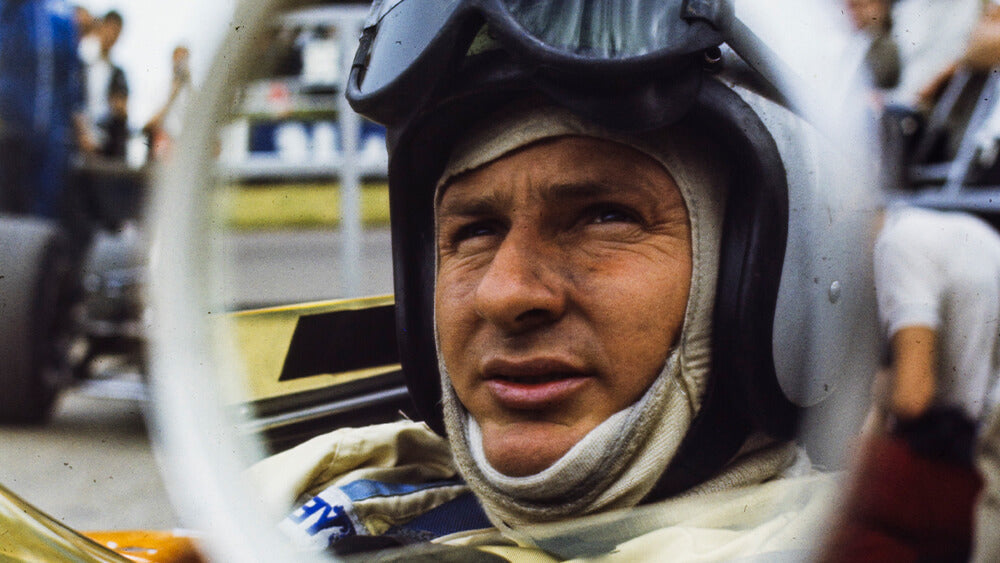Written by Richard Kelley
Bruce McLaren personified the truth that great passion can’t be purchased or sold; it can only be channelled.
From a 15-year-old schoolboy – meticulously rebuilding an old Austin 7 hillclimb car from a box of spares to competing in his first race to Grand Prix victories and multiple Can-Am championships, Bruce wasn’t content to drive fast - he was compelled to push the limits of what was possible, both on and off the track.
But Bruce McLaren was more than just a talented race car driver - he was a visionary, an enthusiastic leader, an innovator, and a true inspiration to generations of motorsports enthusiasts.
 Image Courtesy: Motorsport Images.
Image Courtesy: Motorsport Images.
Born in New Zealand in 1937, McLaren grew up in the small town of Remuera. His parents owned a service station and a workshop, and his father used to race motorcycles and cars. In no time, the 14-year-old teenager found his muse hillclimbing with an Austin 7 Ulster. His natural ingenuity and his raw racing skills took him to 2nd place in the 1957 New Zealand championship series. He never looked back.
In 1959, McLaren joined the Cooper factory F1 team alongside Jack Brabham and won the 1959 United States Grand Prix in far-off Sebring, Florida. At age 22 years 104 days, McLaren was the youngest ever GP winner (not including the Indianapolis 500) up to that time.
This record would stand for over four decades until Fernando Alonso’s victory at the 2003 Hungarian Grand Prix. McLaren followed his first win with victory in the Argentine Grand Prix, the opening race of the 1960 Formula One season. He would cap that season as runner-up champion to team leader Brabham.
 Image Courtesy: Motorsport Images.
Image Courtesy: Motorsport Images.
McLaren captured the 1962 Monaco Grand Prix and finished a solid third place in that season’s championship. By 1963, McLaren’s natural vision and innovative nature saw him founding Bruce McLaren Motor Racing Ltd, now known worldwide as simply McLaren.
By the end of 1965, he was ready. McLaren left Cooper and announced his GP racing team with co-driver and fellow Kiwi Chris Amon. While Amon left to race for Ferrari in 1967, McLaren signed fellow Kiwi Denny Hulme, 1967 world champion (with Brabham) for 1968.
McLaren took his fourth career victory racing his own McLaren car at Spa-Francorchamp in 1968, delivering the team's first Grand Prix win. Hulme won twice in their McLaren-Ford. McLaren's 1969 Formula One championship was equally successful, with the team finishing third in the standings despite taking no wins.
 Image Courtesy: Motorsport Images.
Image Courtesy: Motorsport Images.
After founding the McLaren Racing Team, McLaren began building his first sports car, the M1A. It proved brutally fast in competition. McLaren also debuted his first Formula 1 car, the M2B, at the 1966 Monaco Grand Prix.
But, perhaps Bruce McLaren’s crowning achievement was the debut of the McLaren M1B in the inaugural North American Can-Am series. While many talented drivers in the 1960s could win races, few could develop cars from scratch and then drive them to victory like Bruce McLaren. He possessed every facet of domination: engineering skill, patience, dedication, and enormous natural talent.
His M1B was stunningly quicker around tracks than F1 cars of this era. Striking in their trademark papaya orange paint, McLaren would so thoroughly dominate Can-Am over the next five seasons that the series became known as the Bruce and Denny Show, as McLaren and Denny Hulme claimed one chequered flag after the next. In their spectacular 1969 season, McLaren cars won eleven Can-Am races - every one on the calendar.
 Image Courtesy: Motorsport Images.
Image Courtesy: Motorsport Images.
That domination set Bruce McLaren thinking that sooner or later, other teams would find the same answers and advantages to challenge for the championship. In stepped his McLaren M8D. Sleeker, better balanced and faster, the new M8D demonstrated every facet of Bruce McLaren’s immense talents. Of course, Bruce had to test it to know precisely what needed improvement.
Tragically, McLaren's life was cut short on June 2,1970, when he died testing his new Can-Am M8D on the Lavant Straight just before Woodcote corner at the Goodwood Circuit.
With Bruce gone, partner Teddy Mayer was now the de facto team leader. He was overwhelmed by Team McLaren’s unity on display as he addressed the entire workforce.
“Well, we don’t have a boss, we don’t have a driver, and we don’t even have a car.” he said. But we do have a motor race – at Mosport in two weeks’ time – and we all owe it to Bruce to race. So we might as well get to it.”
“And we did,” remembered Tyler Alexander. “And… we won.”
 Image Courtesy: Motorsport Images.
Image Courtesy: Motorsport Images.
Bruce’s legacy thrives thanks to the continued success of the McLaren team and the countless racers who have been inspired by his dedication to excellence and innovation.
Under McLaren's continuing leadership, the team introduced many groundbreaking innovations, including the first carbon fibre race car and the first use of the wind tunnel in Formula One racing. Further, McLaren became a pioneer in safety, designing and implementing new safety measures that have since become standard in the sport.
 Image Courtesy: Motorsport Images.
Image Courtesy: Motorsport Images.
In the end, Bruce McLaren was more than just a racer - he was a true visionary who changed the face of motorsports forever.














































